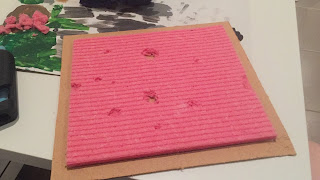 |
| British Rifle/MG Platoons |
Today's update is focused on the just completed platoons of British Rifle/MG Platoons from Plastic Soldier Company. Each Platoon consists of six stands of infantry, one each of a PIAT team, light mortar team, and SMG command team, for a total of nine stands per platoon. There are exactly thirty-four infantry models across all the bases, with two platoons in total complete. The PSC box comes with enough models to make 3 full platoons and company head quarters.
 |
| PSC 15mm WW2 Late War British Infantry |
While good value for money, and being all plastic, this box is excellent for starting an infantry platoon. Unfortunately the box doesn't come with bases, so you will have to source them separately. The sculpts are acceptable, with little in the way of mold lines, and everything is a single piece except for the PIAT teams, two inch mortars teams and Bren gun teams being two piece per model.
 |
| First platoon spread out against a rickety old fence. Bren light machine guns ready to fire. |
British Infantry typically were armed with the bolt action Rifle
No.4, a more easily produced version of the previous Lee-Enfield, still firing the powerful .303-inch round. Peppered through out the platoon were Bren light machine guns, a licensed version of the Czech ZGB 33. The Bren LMG was a reliable workhorse for infantry companies, and soldiers were clamoring to get their hands on more of them. It used the same ammunition as the Rifle No.4, with an RPM between 480 and 540.
 |
| More infantry in the field next door. |
Besides Bren LMG, British infantry platoons also were equipped with Projector, Infantry, Anti-Tank (PIAT) Mk1. Designed in 1942, these anti-tank weapons were quite similar to light mortars in function, but shot with support from the shoulder. These PIATs were generally disliked by the commonwealth troops due to it's inaccuracy and unreliable ammo, and also at just how heavy and bulky it was. However, it was a cheap weapon to produce, and it was excellent for ambushing roles since it didn't have much muzzle blast when fired.
 |
Second infantry platoon, on the far left field. The PIAT on the left, ready to fire.
In the center is the command team, which looks like a lieutenant is a part of. |
The NCO here are sporting the Sten gun, a cheap and simple sub-machine gun developed by the British during the Battle of Britain. While the British were buying up everything they could from the US, it simply wasn't enough to replace all the guns lost during the evacuation at Dunkirk. So the British designed and developed the Sten to complement the numbers of the Thompson SMG bought from across the pond. The Sten shares design features with the Lanchester SMG, which is a design copy of the German MP28 SMG. It uses 19mm rounds and typically had a 32 round capacity magazine. It was described as being highly inaccurate and unreliable, but was easy and cheap to produce, costing 15 shillings during the war.
 |
| Light two inch mortar team in the back ready to fire over the heads of a Bren gun team. |
The two inch mortar was a regular with British infantry. The mortar typically shot a HE round and a Smoke round to a range of about 500 yards. The barrel originally had a sight on it, but was soon dropped as it was unnecessary for front line duty. Instead they had a single white line along the barrel and soldiers simply would line it up and fire. With enough practice, soldiers could accurately hit their targets with this simple system.
 |
Close up of the Bren guns. The box only comes with one type of
model for the Bren gun, so duplication is noticeable here. |
 |
Panorama shot from behind.
The markings on the bases is to denote which platoons they all belong to. |
The paints I used for this are in the picture below. I started with basing the stands with fine dirt, and then undercoating them in Plastic Soldier Army Spray British Khaki. I followed this with Vallejo Model Colour Khaki on the webbing and belts and various pouches, leaving some untouched for variety. Next was the skin, which is Vallejo Model Colour Flat Flesh, and this was the face and hands. The face has a chin strap, so I would come back to this after most of the other colours were done in the clean up phase.

Once the flesh was complete, I decided to paint the base Army Painter Dirt Splatter, and once dry, a light dry-brush of the Vallejo Model Colour Flat Flesh. Then carefully paint the boots with Vallejo Model Colour Black Grey. The weapons are painted Vallejo Model Colour Beige Brown for wood and Vallejo Model Colour Gunmetal Grey. To finish it all off, a quick picking out of the camo leaves on the helmets with Vallejo Model Colour Reflective Green, and a whole model wash of Army Painter Soft Tone, the stuff of champions.
 |
| Another closeup of the infantry. |
The final touches is some Army Painter Field Grass in patches, to simulate French/Holland countryside.
 |
| Ready to go to war to kick some jerry arse! |
Hope you've enjoyed this update, and stay tuned for more.




























































